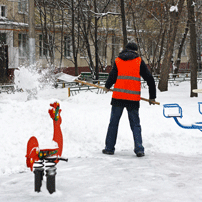Temperature and Work Injuries
January 19, 2018 Did you know that more than 4,000 workers file injury claims every year as a result of temperature-related injuries and illnesses that they sustain? The Occupational Safety and Health Administration (OSHA) reports that bakers, outdoor workers, fishermen, meat packers, recreation/event staff, landscapers and roadway workers are at the highest risk for getting sick or injured as a result of exposures to extreme temperatures.
Did you know that more than 4,000 workers file injury claims every year as a result of temperature-related injuries and illnesses that they sustain? The Occupational Safety and Health Administration (OSHA) reports that bakers, outdoor workers, fishermen, meat packers, recreation/event staff, landscapers and roadway workers are at the highest risk for getting sick or injured as a result of exposures to extreme temperatures.
Although heat can pose a major safety concern and risk to employees, the cold can also result in deadly injuries. Some of the most common injuries sustained as a result of cold temperatures are hypothermia and frostbite. Hypothermia is the result of a drop in body temperature, and is often accompanied by symptoms such as:
- Loss of coordination such as stumbling when walking or fumbling with the hands;
- Drowsiness or exhaustion;
- Mumbled or slurred speech;
- Shivering that can stop as the hypothermia gets worse, and:
- Slow or shallow breathing
Unlike hypothermia, which happens from a drop in body temperature, frostbite is when cold temperatures result in injuries to a person’s body tissue – like skin – due to a reduced supply of oxygen and blood flow to the affected body part(s). Some of the most typical places to develop frostbite are on the toes, feet and/or fingers. Depending on what stage of frostbite a person experiences, the complications range from mild to severe. Frostbite is known to present with:
- Cold skin accompanied by a prickly feeling – this is typically one of the first signs that frostbite is developing;
- Waxy or hard-looking skin;
- Sensation of numbness;
- White, red, bluish-white or grayish-yellow skin;
- Clumsiness and/or decreased range of motion and physical movement due to overall muscle and/or joint stiffness, and:
- Blistering that occurs after reheating
In the most serious cases of frostbite, the body tissue can become necrotic and die. If a person develops severe frostbite, he or she may experience disabling medical complications such as amputation, gangrene, tetanus and other infections. Medical complications from extreme hypothermia are also severe; a person can develop pneumonia, heart problems, kidney failure or hypoxia, which is a lack of oxygen to body tissue.
OSHA finds that certain risk factors are likely to accompany cases of cold stress in workers. Workers with preexisting health conditions like hypothyroidism, hypertension and diabetes are at a greater risk for frostbite and hypothermia. Other known risk factors for cold stress include:
- Dampness/wetness as well as not dressing weather-appropriate;
- Exhaustion, and:
- Poor physical conditioning
In order to limit the number of workers who become ill and/or are injured from cold exposure every year, employers need to take appropriate steps to keep everybody safe. Some of the most effective ways to reduce hazards associated with cold stress is to train employees on cold stress prevention (e.g. dressing properly) and tips on how to recognize the signs of it, as well as to implement various engineering controls throughout the workplace. Engineering controls such as providing radiant heaters, repairing any existing drafts and shielding work areas from wind chill can be especially helpful.
There are some other steps that employers and workers can take to inhibit the likelihood of hypothermia, frostbite and other complications from cold stress and exposure.
Maintaining a healthful and safe workplace needs to be a priority for each and every employer. When temperatures are especially low and outdoor tasks are necessary, work should be scheduled during the warmest hours of the day. It’s crucial that workers wear weather-appropriate clothing such as multiple layers, hats, gloves, boots and face masks (depending on the temperature). If you have any questions about ways your employer can keep you protected from cold exposure, or if you became ill or were injured as a result of medical complications from cold stress in the workplace, please contact a representative at our firm.
Allentown Workers’ Compensation Lawyers at Galfand Berger, LLP Represent Individuals Injured on the Job
If you experienced medical complications like hypothermia or frostbite from cold stress exposure in the workplace, please contact our Workers’ Compensation lawyers in Allentown. With offices located in Philadelphia, Bethlehem, Lancaster, and Reading, Galfand Berger serves clients throughout Pennsylvania and New Jersey. To schedule a consultation, call us at 800-222-8792 or complete our online contact form.
 Google Screened
Google Screened
